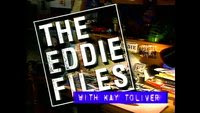We're making room in the Media Center for new materials and a big stack shift because we have $5000 of new books (mostly fiction requested by kids & teachers) - and we're taking a hard look at what has not been used lately on our AV shelves and we're stuck on a GREAT series of Real Life Math action called the Eddie Files. We have 12 Videos: Each about 20 min and a full teacher's guide with lesson plans and the topics seem super cool! (see very bottom for series list) So the question is Math teachers....should they stay or should they go?
 If they stay...will you try and use them? Give them a shot? They're VHS and a little dated, Ok....and the replacement set in DVD is $369....but we have them here...right now...for you...cataloged and just waiting to be discovered and used....OR should we weed them and make room for new materials. Oh and I checked...there's not an updated version...re-shot, re-casted, with similar subject matter.
If they stay...will you try and use them? Give them a shot? They're VHS and a little dated, Ok....and the replacement set in DVD is $369....but we have them here...right now...for you...cataloged and just waiting to be discovered and used....OR should we weed them and make room for new materials. Oh and I checked...there's not an updated version...re-shot, re-casted, with similar subject matter.Why Love Eddie and Ms. Tolliver?

"Through the eyes of Eddie, a fictional 6th grade student in real-life East Harlem math teacher Kay Toliver’s class, viewers discover how people use key math concepts and skills in the workplace. The series includes four “fileboxes” each with 4 episodes and accompanying teacher guide.
20-minute programs, each of which deals with a different topic of the elementary/middle mathematics curriculum. Through the eyes of "Eddie," a 5th grade student in the mathematics classroom of renowned teacher Kay Toliver, viewers find out just how people use key math concepts and skills in life and in exciting jobs.
Endorsed by NAESP, American Association of School Administrators, National Educational Telecommunications Association, NSTA. More than 20 awards, including Peabody and Parents' Choice Awards."
Four "Fileboxes," each with 4 episodes and accompanying teacher guide.
Welcome to Math #101
Eddie's first assignment in Kay Toliver's class is to find out about how people use math in their jobs.
Estimation #102
With help from professionals who use estimation, Eddie makes an educated guess about the number of dogs in New York City.
Geometry #103
Eddie learns how polygons are used to create everything from skyscrapers to collapsible spheres.
Fractions #104
Eddie discovers surprising things about fractions from a chef, a percussionist, and a sports photographer.
Hot Dog Heaven (Distance, Time, and Speed) #201
While Eddie looks for a lost dog, transportation professionals explain how millions of people move around New York City every day.
The Lucky Batting Glove (Statistics) #202
Eddie and Aunt Rosa discover the roles of mathematics in business and sports.
The Veggie Stash-o-Matic (Circles) #203
Eddie works on his assignment—inventing a machine—as designers and engineers share the practical uses of geometry.
The Fake Money Caper (Decimals) #204
To help Secret Service agents track down counterfeiters, Eddie consults with people who create and safeguard the money supply.
Sleep Like a Dog (Length and Area) #301
When Aunt Rosa's dog is cast in a commercial, Eddie learns how people who design and make television and movie sets use math.
The Big Concert (Patterns) #302
While Eddie is preparing for his school's holiday concert, he learns how musicians use patterns.
The Day Manhattan Ran Dry (Volume) #303
Eddie meets people who make sure Manhattan never runs out of water.
Eddie in Barbieland (The Counting Principle) #304
When Eddie is asked to shop for doll clothes for his sister's birthday, he gets help from his teacher and some toy designers.
The Lonesome Pine (Ratios) #401
With the help of foresters and engineers, Eddie looks for a place to plant a young pine tree in Manhattan.
The Green Thumb (Variables) #402
Eddie receives advice from gardeners and a farm manager about the sunflower he is growing for Ms. Toliver's class.
The Dessert Derby (Charts and Graphs) #403
Eddie's Aunt Ida follows professional advice and uses charts and graphs to compete in the East Harlem Community Center's dessert derby.
Take a Bite (Percents) #404
Eddie sees how Ms. Toliver's lesson on percentages applies to graphic design when his photo is chosen for a campaign to bring tourists to New York City.
Series listing from KET









